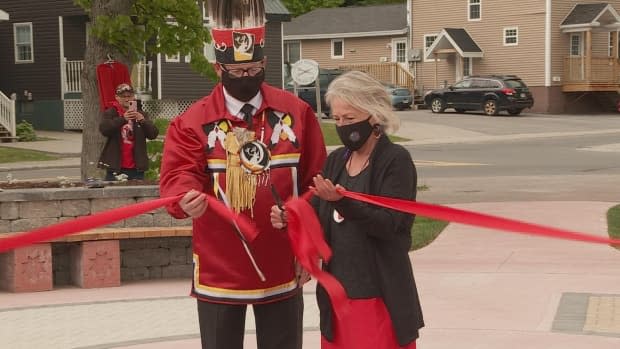Corner Brook celebrations honour lost Indigenous women through new community garden


Two new symbols to honour and recognize Indigenous people of the past, present and future were unveiled in Corner Brook on Friday
The Mikwite'tm Garden — which translates to I remember — opened to serve as a tribute and memorial in honour of missing and murdered Indigenous women and girls across the country.
Qalipu artist Jenny Brake's work was selected to serve as the centrepiece of the garden, a painting created in honour of women both lost and currently struggling.
"The circle of women represent people that I know and I love and I've lost," Brake said Friday. "Women from all over Newfoundland and Labrador."
"I'm really happy for my children and my children's children and all of our children's children, because the ones that are lost can't be here today. It means a lot to put this there for them to share and be proud of."

The opening of the garden was commemorated with a ceremony that included Miawpukek First Nation Chief Mi'sel Joe, Labrador MP Yvonne Jones and more. The park was officially opened with a ribbon cutting by Glenda Buckle, who lost her sister, Janet Louvelle.
It's a symbol of love. It's a love of every culture around us. - Kaylee Sullivan
At Memorial University's Grenfell Campus earlier in the day, a crowd gathered to celebrate the raising of the Mi'kmaq Grand Council Flag.
Kaylee Sullivan, a historical and English studies student at Grenfell while working for Qalipu First Nation, helped raise the flag. She sees it as a tribute to remember all past and present Indigenous students, along with those who will attend in the future.
"It represents our culture. It represents the people that are here on this nation and in the Grenfell university campus," Sullivan said.
"As a student, it means I can come to campus everyday and be proud of my culture, and be proud to show who I am and what I represent. And the history of these people here."

Sullivan said the flag also serves as a symbol of acceptance and compassion for other students who travel to the region to study.
"It's a symbol of love. It's a love of every culture around us," she said.
"We are an international campus with a lot of international students. So this shows a love of the people that were here, the people that are still here and the love that we share today."
Memorial President Vianne Timmons, who is Indigenous and had family grow up in the region, said the move is the first of many in an effort to make sure the stories of Indigenous peoples "aren't invisible" on campus.
She said support could come through added supports for Indigenous students, bringing more Indigenous elements like paintings into the school's surroundings, and more.
"We can think of Indigenization as a lense we look at everything we do through," Timmons said.
"There's a lot more we can do, and there's a lot more we will do."

 Yahoo Movies
Yahoo Movies 